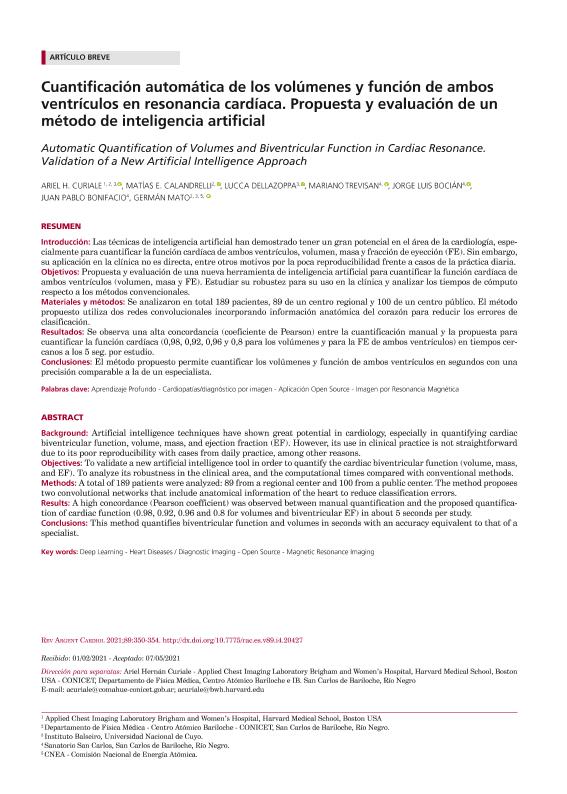Artículo
Background: Artificial intelligence techniques have shown great potential in cardiology, especially in quantifying cardiac biventricular function, volume, mass, and ejection fraction (EF). However, its use in clinical practice is not straightforward due to its poor reproducibility with cases from daily practice, among other reasons.
Objectives: To validate a new artificial intelligence tool in order to quantify the cardiac biventricular function (volume, mass, and EF). To analyze its robustness in the clinical area, and the computational times compared with conventional methods.
Methods: A total of 189 patients were analyzed: 89 from a regional center and 100 from a public center. The method proposes two convolutional networks that include anatomical information of the heart to reduce classification errors.
Results: A high concordance (Pearson coefficient) was observed between manual quantification and the proposed quantifica- tion of cardiac function (0.98, 0.92, 0.96 and 0.8 for volumes and biventricular EF) in about 5 seconds per study.
Conclusions: This method quantifies biventricular function and volumes in seconds with an accuracy equivalent to that of a specialist. Background: Artificial intelligence techniques have shown great potential in cardiology, especially in quantifying cardiac biventricular function, volume, mass, and ejection fraction (EF). However, its use in clinical practice is not straightforward due to its poor reproducibility with cases from daily practice, among other reasons.
Objectives: To validate a new artificial intelligence tool in order to quantify the cardiac biventricular function (volume, mass, and EF). To analyze its robustness in the clinical area, and the computational times compared with conventional methods.
Methods: A total of 189 patients were analyzed: 89 from a regional center and 100 from a public center. The method proposes two convolutional networks that include anatomical information of the heart to reduce classification errors.
Results: A high concordance (Pearson coefficient) was observed between manual quantification and the proposed quantification of cardiac function (0.98, 0.92, 0.96 and 0.8 for volumes and biventricular EF) in about 5 seconds per study.
Conclusions: This method quantifies biventricular function and volumes in seconds with an accuracy equivalent to that of a specialist.
Cuantificación automática de los volúmenes y función de ambos ventrículos en resonancia cardíaca: Propuesta y evaluación de un método de inteligencia artificial
Título:
Automatic Quantification of Volumes and Biventricular Function in Cardiac Resonance: Validation of a New Artificial Intelligence Approach
Curiale, Ariel Hernán ; Calandrelli, Matías Enrique; Dellazoppa, Lucca; Trevisan, Mariano; Bocián, Jorge Luis; Bonifacio, Juan Pablo; Mato, German
; Calandrelli, Matías Enrique; Dellazoppa, Lucca; Trevisan, Mariano; Bocián, Jorge Luis; Bonifacio, Juan Pablo; Mato, German
 ; Calandrelli, Matías Enrique; Dellazoppa, Lucca; Trevisan, Mariano; Bocián, Jorge Luis; Bonifacio, Juan Pablo; Mato, German
; Calandrelli, Matías Enrique; Dellazoppa, Lucca; Trevisan, Mariano; Bocián, Jorge Luis; Bonifacio, Juan Pablo; Mato, German
Fecha de publicación:
10/2021
Editorial:
Sociedad Argentina de Cardiología
Revista:
Revista Argentina de Cardiología
ISSN:
0034-7000
e-ISSN:
1850-3748
Idioma:
Inglés
Tipo de recurso:
Artículo publicado
Clasificación temática:
Resumen
Archivos asociados
Licencia
Identificadores
Colecciones
Articulos(CCT - PATAGONIA NORTE)
Articulos de CTRO.CIENTIFICO TECNOL.CONICET - PATAGONIA NORTE
Articulos de CTRO.CIENTIFICO TECNOL.CONICET - PATAGONIA NORTE
Citación
Curiale, Ariel Hernán; Calandrelli, Matías Enrique; Dellazoppa, Lucca; Trevisan, Mariano; Bocián, Jorge Luis; et al.; Cuantificación automática de los volúmenes y función de ambos ventrículos en resonancia cardíaca: Propuesta y evaluación de un método de inteligencia artificial; Sociedad Argentina de Cardiología; Revista Argentina de Cardiología; 89; 4; 10-2021; 1-5
Compartir
Altmétricas



